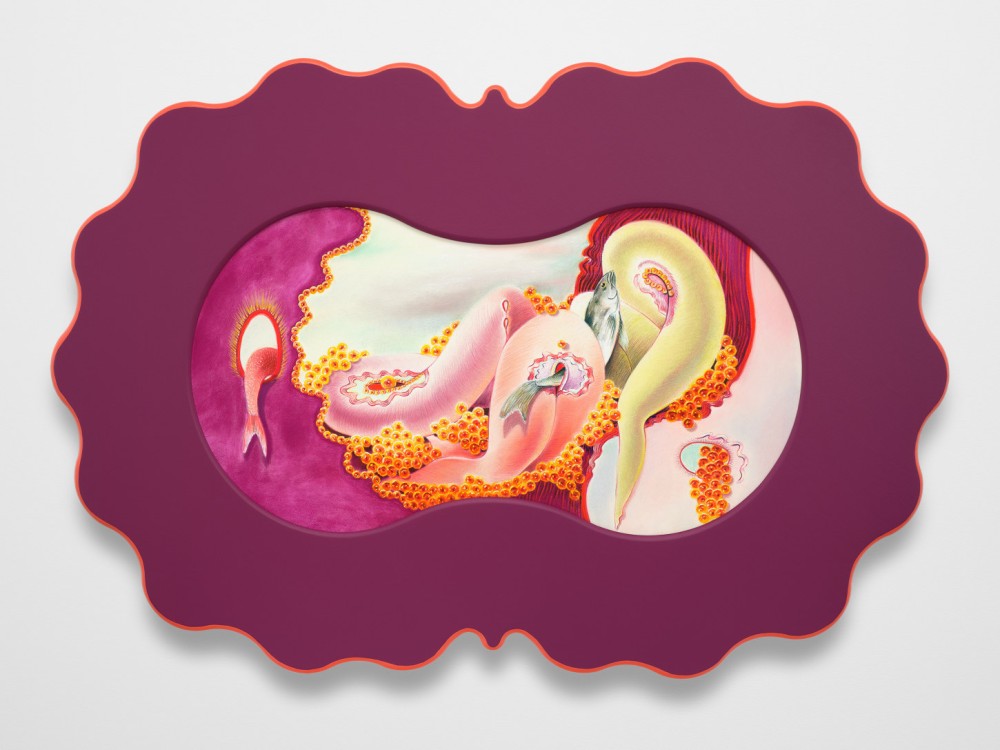
MAUREEN ST. VINCENT: MAENADS
A native of San Luis Obispo, St. Vincent’s paintings marry the Rococo kitsch of California’s Central Coast with a symbolic repertoire culled from mythology, folktales, and the long history of art. Across ten sumptuous surfaces, fish, grapes, and other, more abstract objects intertwine and dangle from bodiless legs and ovular forms, conjuring fantastic landscapes of visceral sensation.
At once grotesque and alluring, this fantastic world of monstrous femininity alludes to the imagery that haunts our collective unconscious: the unruly, reproductive body of sirens and witches, gorgons and banshees. Such representations of woman-as-monster recur across human societies as metaphors for repressed desire and savage impulse. Take the mythic Selkie–a seal like creature of sea and land–who, though robbed of her animal skin, cannot thrive in motherhood or domesticity. Forever caught between nurture and destruction, beauty and abjection, human and animal, she awaits her return to the wild sea.
Yet, though often named for mythic female archetypes, St. Vincent’s alien creatures seek pleasure in the commingling and cross-contamination of these realms. They lounge and frolic within their discomfiting surroundings, coiling around one another and embodying the drunken madness of the maenad—female followers of the Greek God Dionysus that roamed the mountains and forests performing frenzied, ecstatic dances. The artist recalls her childhood on the Central Coast, surrounded by vineyards and the campy-baroque architecture of landmarks like the Hearst Castle and the Madonna Inn, in not un-similar terms. In an artwork like Pacific Catch, we glimpse the coastline where the artist did her own reveling, introducing the specificity of place into the otherwise otherworldly imagery.
The relay between real and imagined registers is heightened by the curving, ovular forms of St. Vincent’s artist-designed frames. Up to eight inches wide on a side and painted in flaming purples and deep maroons, their architecture protects the realm of feminine fantasy that we peek through their apertures. The proliferating, doubling form of these symmetrical frames moreover recall the vulva and other bodily orifices, emphasizing the erotic nature of her imagery, and harkening back to the ever-presence of the Shadow Self—the Ego’s twinned unconscious laden with all that is repressed, cast aside, or unassimilable.
Born with a twin and a mother of two, St. Vincent traffics in promiscuous slippages between the realms of rationality and of the untamed shadow–like the Selkie waiting for her seal song.
–– Frances Lazare
Maureen St. Vincent (b.1984 San Luis Obispo, CA) currently lives and works in Oakland, CA. Using a surrealist vocabulary, St. Vincent explores erotic pleasure and the part-body. Disembodied forms decorate the paper to imply vestiges of corporal experience, freed from rationality. The isolation of anatomical parts evokes an out-of-body experience: the moment when the body tingles, wanders away from the earth, and relinquishes control. Her work has been featured in multiple publications including Brooklyn Rail, ArtMaze Magazine, Artnet News, and Art of Choice. Recent exhibitions include Maureen St. Vincent, Nicodim Upstairs, Los Angeles (2024, solo, forthcoming); Ripple Hiss, Fesse Flatow, New York City (2022, solo); Fêtes Galantes, Moskowitz Bayse, Los Angeles (2022, solo); You Me Me You, Nicodim Gallery, Los Angeles (2022); Mother Lover, Zoe Fisher Projects, New York City (2021, solo); Eartha, Adams and Ollman, Portland (2020); Morro Madonnas, San Luis Obispo Museum of Art, San Luis Obispo (2019); and Garden Dwellers, Regina Rex, New York City (2017).